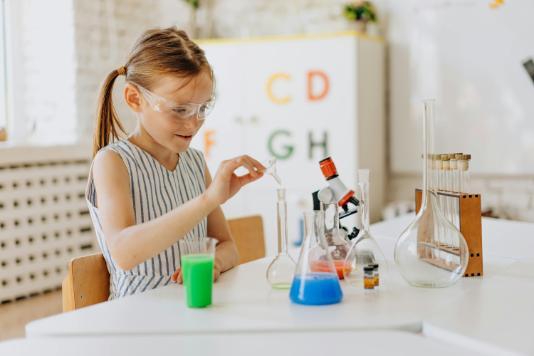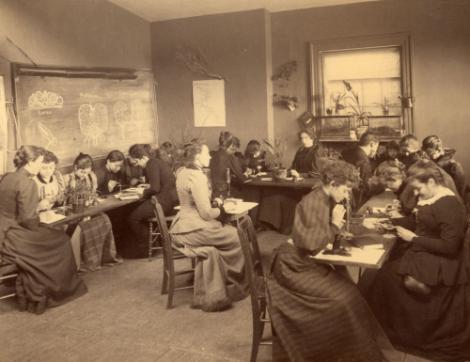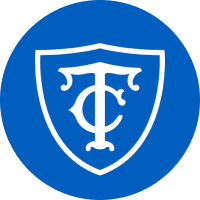Today In History: International Day of Women and Girls in Science

But we must not forget that when radium was discovered no one knew it would prove useful in hospitals. The work was one of pure science. And this is a proof that scientific work must not be considered from the point of view of the direct usefulness of it. It must be done for itself, for the beauty of science, and then there is always the chance that a scientific discovery may become like the radium a benefit for humanity. -- Marie Curie, The Discovery of Radium ... Address by Madame M. Curie at Vassar College, May 14, 1921.
February 11th is the International Day of Women and Girls in Science, and 2025 marks the 10th anniversary of the annual observance that was formally established by the United Nations to raise awareness of gender equality and appreciation for women's achievements in STEM (Science, Technology, Engineering, and Mathematics). With female underrepresentation in science and technology over the decades, many organizations and institutions throughout the world are working to enhance opportunities for women and girls, including education and dissolution of social barriers and biases that have prevented women from engaging in STEM fields -- among them, discriminatory labor practices, early marriages, and traditional views of women in the home.
We give a nod to many female pioneers throughout history who pursued their interests and successfully contributed to science in all its branches, including, but not limited to the fields of physics, chemistry, medicine, astronomy, computing, biology, paleontology, and zoology -- from experiments in the lab to interactions in the jungle, from ancient remains to rockets in space, from the tiniest genetic code to the first computer program. Represented in the selection of historical news are Marie Curie, Elizabeth Blackwell, Mae Jemison, Rosalind Franklin, Kalpana Chawla, Mary Anning, Rachel Carson, Jane Wright, Jane Goodall, and Ada Lovelace -- examples of remarkable women in science.
And, with appreciation for countless women in science education, technology, mathematics education, and the applied health sciences at Teachers College, Columbia University, we look to the past, present, and future -- from Miss Schreiber, Instructor of Natural Science, at 9 University Place (the 1887 site for the New York College for the Training of Teachers , now Teachers College); to Dr. Felicia Mensah, Professor of Science and Education, Chair of the Department of Mathematics, Science and Technology, and Science Education Program Director; to all our students in STEM fields who are teaching the next generation.

The following articles are drawn from Proquest Historical Newspapers, which informs and inspires classroom teaching and learning.
- My Life and Work: What Radium Can Do for Humanity. (1929, Jun 08). The Times of India (1861-)
- The First Woman Doctor. (1949, Jan 23). New York Times (1923-)
- Mae C. Jemison: A Pioneer American Space Traveler. (1993, Feb 12). Philadelphia Tribune (1912-)
- Robin, M. H. (2002, Sep 29). Not So Elementary, Watson: A Life of Rosalind Franklin, the Mistreated Co-Discoverer of DNA. New York Times (1923-)
- Olivera, R. (2003, Feb 04). 'Kalpana Chawla Taught Us That Nothing's Impossible': Star Gazers. The Times of India (1861-)
- Bouton, K. (2010, Feb 02). Books on Science: Tale of an Unsung Fossil Finder, in Fact and Fiction. New York Times (1923-)
- Royte, E. (2012, Sep 16). The Poisoned Earth: A New Biography of Rachel Carson, Who Warned Against the Indiscriminate Use of Pesticides. New York Times (1923-)
- Weber, B. (2013, Mar 03). Jane Wright, 93, Oncology Pioneer, Dies. New York Times (1923-)
- Tullis, P. (2015, Mar 15). Wild at Heart: Half a Century Ago, Jane Goodall Journeyed into the Jungle to Change How the World Saw Chimpanzees. Today She Travels the World to Save Their Lives. New York Times (1923-)
- Thompson, C. (2019, Feb 17). The Secret History of Women in Computing: Computer Programming Once Had Much Better Gender Balance Than It Does Today. What Wrong? New York Times (1923-)

Tips:
- Baker, D. R. (2016). Understanding Girls : Quantitative and Qualitative Research (1st ed. 2016.). Sense Publishers. e-book.
- Hanson, S. L. (2009). Swimming Against the Tide : African American Girls and Science Education (1st ed.). Temple University Press. e-book.
- Holt, Nathalia. Rise of the Rocket Girls: The Women Who Propelled Us, from Missiles to the Moon to Mars. New York : Little, Brown and Company, 2016. Butler, Barnard; TL862.J48 H65 2016.
- Koch, J., Polnick, B., & Irby, B. (2014). Girls and Women in Stem : A Never Ending Story. Information Age Publishing. e-book.
- Sosale, S., Harrison, G. M., Tognatta, N., Nakata, S., Brown, S., & Holtz, P. (2023). Engendering Access to STEM Education and Careers in South Asia (1st ed.). World Bank Publications. e-book.
- Summary and Analysis of Rise of the Rocket Girls : The Women Who Propelled Us, from Missiles to the Moon to Mars : Based on the Book by Nathalia Holt. (2017). Worth Books. e-book.
- Thimmesh, C., & Sweet, M. (2002). The Sky’s the Limit : Stories of Discovery by Women and Girls. Houghton Mifflin. Curriculum ; QB163 .T478 2002
- Tolley, K. (2013). The Science Education of American Girls : A Historical Perspective (1st ed.). Routledge. e-book.
Images:
- A Girl Doing a Science Experiment, by Mikhail Nilov, Courtesy of Pexels.
- Class In Natural Science. Miss Schreiber, Instructor. 9 University Place. Teachers College. (Date Not Known), Historical Photographs of Teachers College, Courtesy of Teachers College, Columbia University.
- A Girl Conducting a Science Experiment, Courtesy of Canva.
Need to keep current, look to the past, teach a topic? The Everett Cafe features daily postings of news from around the world, and also promotes awareness of historical events from an educational context. Be sure to check additional Cafe News postings on the library blog.

